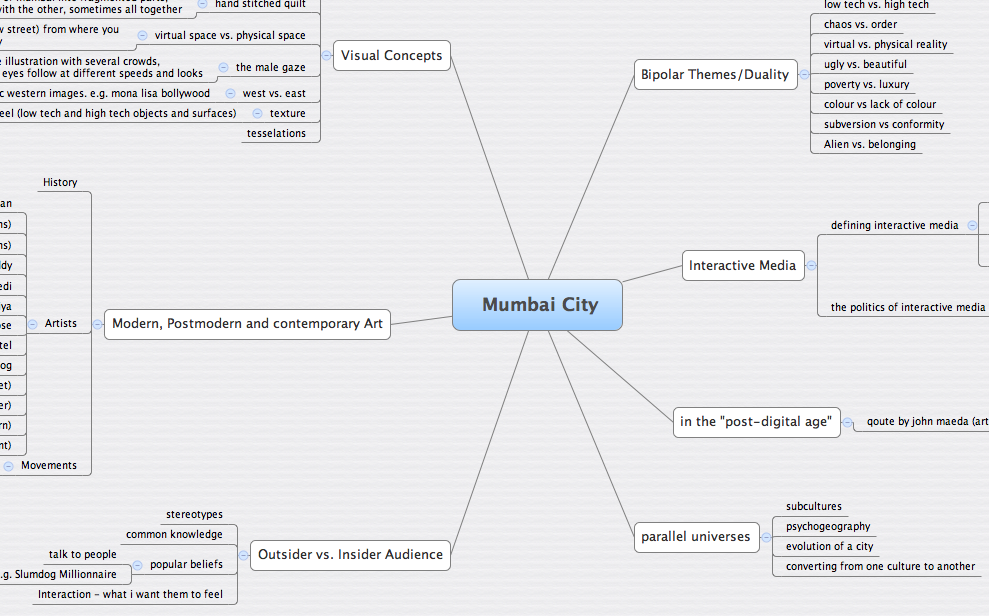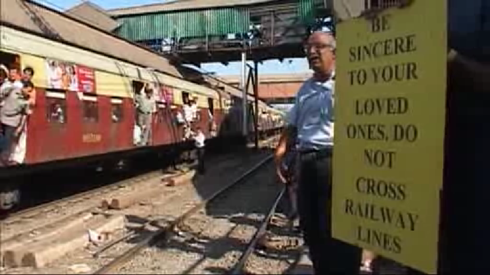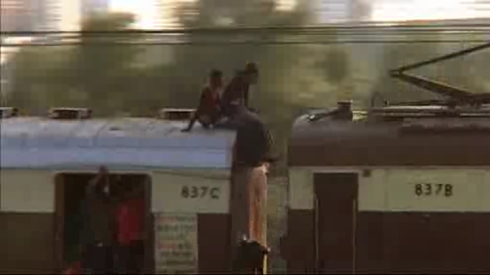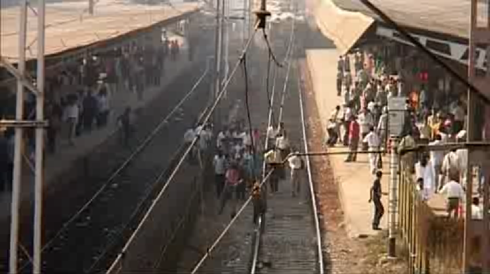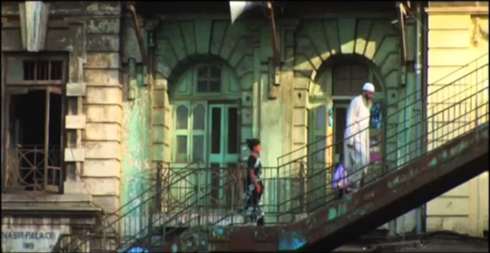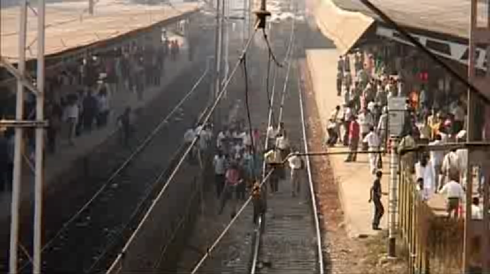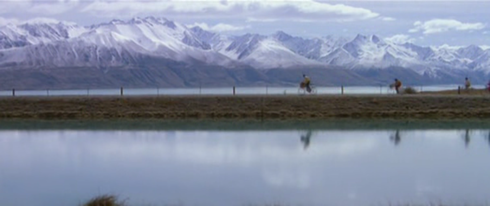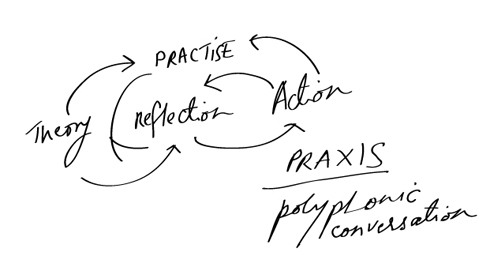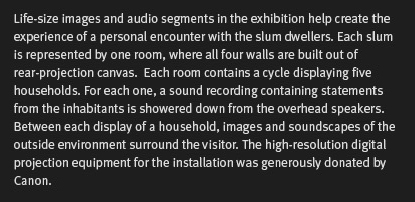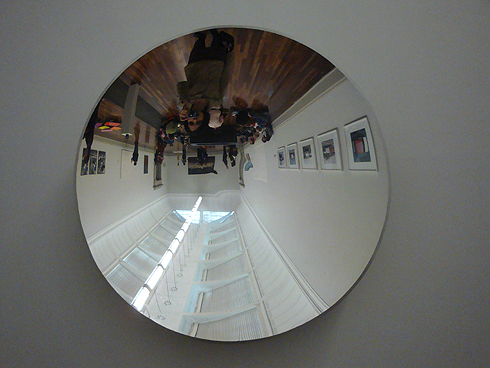Research Methods: Phase 1
A detailed look at the theoretical framework and research methods behind my practice in Phase 1. Key issues discussed are practice as research, the post-digital age, heterotopia, qualitative research methods, and limitations of these methods.
We've had several inputs on practice as research, however Dr. Sally Mackey's lecture helped clarify my ideas on the topic. Besides talking at length about the praxis between theory, reflection, action and practice she also mentioned creating a laboratory; an ideal set-up that would help answer and clarify the key questions of the research. The lab I have created is an installation space that allows the audience to interact with the work and each other. By continually experimenting in this interactive space I am able to clarify my key questions and focus my research topic further.
Currently I am attempting to transform a range of questions into one key point. Below is a list of possible topics of enquiry: How does the user's interaction with the space help add meaning to the work Mumbai+Bombay? How can an interactive space illustrate the conflict between the ideal elsewhere and the here in Mumbai? How does audience behavior and expectation affect the perceived meaning of the work Mumbai+Bombay? What is the perceived difference between an "insider" and "outsider" in viewing the work Mumbai+Bombay?
Dissemination and Application: Another important factor to consider is the dissemination of the final work. The web is the most easily accessible form the final work can take. Additionally, the work can be set up in a gallery or informal space as a more immersive experience of changeable dimensions.
Theoretical Framework:
Post Digital Age: As mentioned in my preliminary Study Plan the concept of a post-digital age introduced by John Maeda made a significant impact on my philosophy as a designer of interactive media. The terms clarifies the 'distinction between those that are passed their fascination with computers, and are now driven by the ideas instead of the technology (John Maeda, 2006).’
Heterotopia's and 'Other' Spaces:
Michel Foucault (1967) describes heterotopias as "places that do exist and that are formed in the very founding of society - which are something like counter-sites, a kind of effectively enacted utopia in which the real sites, all the other real sites that can be found within the culture, are simultaneously represented, contested, and inverted. Places of this kind are outside of all places, even though it may be possible to indicate their location in reality." Thus all cultures and civilizations contain such places. Foucault goes on to describe several different kinds of heterotopias, of which the following were most relevant to my practice.
Heterotopia of compensation: Especially relevant to colonies, these places are contrary by way of compensation and function between two extreme poles (Foucault, 1967):
"...their role is to create a space that is other, another real space, as perfect, as meticulous, as well arranged as ours is messy, ill constructed, and jumbled. This latter type would be the heterotopia, not of illusion, but of compensation, and I wonder if certain colonies have not functioned somewhat in this manner. In certain cases, they have played, on the level of the general organization of terrestrial space, the role of heterotopias."
Another example of a heterotopia is the "persian garden," where several plants and flowers from around the world co-exist in a small place which is like a microcosm of the larger world; "the garden is the smallest parcel of the world and then it is the totality of the world. The garden has been a sort of happy, universalizing heterotopia since the beginnings of antiquity..." Similarly by constructing a limited cityscape which includes as many landmarks and symbols as possible, I will attempt to explore this "other" space within Mumbai.
Research Methods
Qualitative Research: Systematic study of Mumbai and the ways the city is represented in popular media and art. Typical of qualitative research, this included looking at chosen media and art works in a case-based method. Each film, artwork, architectural style or documentary chosen for study was reviewed in detail. Thus the method encouraged looking into each case study in-depth rather than covering a broad overview of every possible representation of the city.
Interviews: Sudhir Patwardhan is an important artist within the Indian contemporary art movement, and his practice centers on Mumbai and it's people. Deeply influenced by his work Silent Town (2007) I contacted him by email in the beginning of Phase 1 for pointers on which artists and books I should study, since I found the lack of information of Indian contemporary art challenging. Here is an excerpt from his email which answers some of my questions:
Reflexive Journal: Commonly used as part of qualitative research, a regularly updated reflexive journal of my thoughts, comments and ideas helped document my progress. The journal or blog is a complimentary annotation to the work.
Analysis of documents and materials: A continuous process of reviewing the cases studies, and their importance in answering the research questions. An important factor was reviewing the source itself, it's reliability and validity.
Analysis
In trying to maintain a "polyphonic conversation" between my practice and my research I have fallen into a method which is similar to a communication design process. The cyclical process-driven method of research Sally Mackey calls "praxis" is another way to describe the "design process" - a rigorous method of study and design followed by reflection, study and more design. One main difference is the stage of user-testing that most often precedes another round of reflection.
Phase 1 consisted of a similar cyclical research method. Creating a lab, or in this case an installation space where I can test the limits of my key questions, and then going back to the drawing board based on the results. This cycle of experiment, reflection and experiment helped clarify my theoretical framework as well as my practice. An important aspect of my reflection was discourse, relevant conversations with peers, faculty and artists.
Data collection and analysis of what was relevant to the project was challenging due to the significant amount of information available. Process involved choosing case-studies based on relevance to the project, and discarding information that did not fit within the required parameters such as visual style, architecture, historical significance, concept and theoretical framework. At the same time the lack of information within certain areas proved difficult. The information on the development of contemporary art in India was limited and in some cases contradictory. The history of Mumbai itself is long and complicated, a series of conflicts with contrary histories. Some of these issues resolved themselves in time through action. Others clarified when I drew on six years of personal experience, living as a Mumbaikar.
Another hurdle is my limited access to Mumbai itself. To overcome this, I will be travelling to Mumbai for ten days to collect information, visit artists, shoot films and record street sounds based on my findings in Phase 1.
Despite the above mentioned limitations, maintaining regular blog entries of my progress allowed me to pinpoint and correct events that were most influential or most detrimental to the development of my practice, and critically review the leaps I made from research to practice or vice versa.
Reference:
John Maeda. (2006). No Crackle Pop [online]. Available from: http://www.maedastudio.com/2006/burn/index.php?category=all&next=exists&prev=exists&this=burn [Accessed 21st October 2010]
Foucault, M. (1984) Des Espace Autres. Architecture /Mouvement/ Continuité. [online] Oct. 1984. Translated from French by Jay Miskowiec. Based on a lecture by Michel Foucault on March 1967. Available from: http://foucault.info/documents/heteroTopia/foucault.heteroTopia.en.html. [Accessed 5th Jan 2010]
Mackey, S (2010). Practice as Research: Performance, Place and Documentation. Arts University College at Bournemouth. 9th November.
Patwardhan, S. (patwardhansudhirATyahoo.com). 18th October 2010. Re: Questions from an art student. Email to A.Kulkarni.(aditi.aduATgmail.com)
Documentary: Bombay Railway
Bombay Railway is a two-part documentary by BBC 4 that paints a picture of an overcrowded train system pushed to its limit by 6 million commuters a day, full of people who strive towards their goals tirelessly, in the city of dreams that is Mumbai. I was a frequent traveller myself, so it was interesting to watch the documentary which is from the point of view of an observer rather than someone who has lived the experience. What we call "Crush" is the super rush hour that's also mentioned in the film, and the statistics and video footage is more frightening than actually travelling in the crowd. As an observer, the sight of 5000 or more people getting into trains meant for 1200 people within 30 seconds is a spectacle. As a participant it's an exciting, thrilling, and somewhat harrowing daily reality. The fact is that the local trains are cheap, charging about 1 penny a mile and the trains are always on time with a 97% efficiency, so despite the odds the system is dependable and vital to the normal functioning of Mumbai.
In the first part of the film, the stories about runaway kids living on Mumbai platforms sounds sunny and positive, giving the audience hope that things could turn out well for these children that have escaped abusive families. However describing a railway station as a "family" where you get to "be yourself" is overly optimistic and misleading. Most of these runaways end up being abused, drugged and treated badly. I have seen them being thrashed by cops or others on more than one occasion. Life for kids in such places is rarely a happy place.
Various other issues such as illegal hawking, crossing tracks, and the terrorist bombings are also mentioned. Below are a few screenshots from the film:
Documentary: Shot in Bombay
[vimeo http://www.vimeo.com/6735583] The documentary uses a lot of "typical" shots of Mumbai, shots of the streets, children, and film sets, with catchy Bollywood music in the background. The opening sequence above is especially successful in creating a rich, romantic atmosphere. Here are some screenshots from the sequence which best represent this slice of the city:
Related Posts that study the city's representations in the media: Bombay Cinema, An Archive of the City | Elsewhere Places | Bombay Book Cover | 26/11 Attack | Dharavi Documentary | Places we Live
Group Critique
Overall Feedback:Brian Catling (performance artist and poet) mentioned that I could add a layer of virtual shadows to the video installation, in addition to the real shadows thrown by the audience. He also mentioned that since the user's action is central to viewing the work, it's almost as if the user is causing the resulting violence/action, in this case the image of a burning building that becomes visible only in the user's shadow. In answer to my question about the kind of space I should use for the installation, he said that using a clean, "constructed" white room would work best with the concept. There was a brief discussion on the lack of sound used, and he thought that sound was not required at all.
Several artists and films that could help develop my practice were mentioned: such at Kit Wise, Rope by Hitchcock and "London" and "Robinson in Space" by Patrick Keiller. I was also directed to Foucault's theories of Heterotopia, Dystopia and Utopia; "Non Places - Introduction and an Anthropology of Super Modernity" by Mare Ange and the History of the Shadow by V. Strichita.
Reflection: The use or lack of sound is an important issue which I still have to properly integrate into the concept of the bipolar, constructed realities. However I agree with Brian in that the sound itself is not very important to the installation. It is a concern to me that the sound or music could dominate the visuals. The result should be dream-like, since dreams have a tendency to have faded or muted sounds when remembered. Examples of appropriate sounds are: muted voices, very low volume music, or something subtle such as crackling of fire and gunshots in the distance. During the presentation I also realized that a subtle difference between the "here" and the "elsewhere" is better than an overly dramatic and "literal" difference. The space itself is still an issue which I need to work on to some extent. A large part of phase 2 will be building on the space, experimenting with the use of objects along with projectors, and trying the 360 degree panorama. Overall, creating the presentation helped me organize my thoughts in terms of the kind of framework and process I followed, looking at the gaps in my reasoning and further steps I needed to take in my research.
Notes: Topics to read further: Para-Feminism, Invisible artwork, Family photographs as imposed memories, Leonard Talmy: Force Dynamic in language: "door is closed" vs the "door cannot be opened." Uses of Enchantment by Bruno: interesting book about fairy tales, Costume vs. Fashion is the folk (narrative, story) vs. elite (market, consumer); Physiology of taste by Brillat Savarin; Dutch golden age (objects with meaning, symbols) - using a room or a window to project against or using meaningful objects in the installation; Shadows: Using shadows in different tones, different light sources. Also interesting is the book Praise the Shadow; Constructed Reality: creating from photographs, memory, or not even that, but just found photographs is one step down. Films: Many Moons (2008) b Janelle Monae; Coraline (animation); Eraserhead by David Lynch
Bombay Cinema: An Archive of the City
Initially the concept of the "elsewhere" that inspired my focus on the conflict between the real and the ideal in Mumbai came from an article by Ashraf K. Kazi about the "Masala City." He went on to give examples from Bollywood movies such as Mein Prem Ki Diwani Hoon, where the entire movie unfolds in an imaginary Indian town called Sundarnagar. This lead me to look into Bollywood and the ways it represents Mumbai. The movie-making industry in Mumbai has come of age - now more than a 100 years old, and it reflects the city's conflicts, politics and desires as much as its people. Excerpts from the book Bombay Cinema by Ranjani Mazumdar:
"The Bombay-based film industry resonates throughout the world, in places where the Indian diaspora has settled and in places where nonnative speakers appreciate its unique choreography of music, melodrama, fantasy, and spectacle. Much of popular cinema’s success can be attributed to what many in the industry refer to as a “techno folk” form, which combines folk traditions with new cinematic technology."
"Drawing on various visual, literary, and artistic traditions, each with its own distinct history, popular Indian cinema is an evolving, unabashedly hybrid cultural form that narrates the complicated intersection between tradition and modernity in contemporary India. Film production started in India almost simultaneously with other filmmaking countries, beginning in 1896."
The author also mentions the Indian street, as a place which contains Indian life and all its related conflicts. Although I am currently focussing on building a virtual Mumbai skyline, creating a street could also interest me in the future.
"In a rare piece, Arjun Appadurai describes the Indian street as the space where “India eats, works, sleeps, moves, celebrates and worships. The street is a stage that rarely sleeps” (1987, 14). Through a vivid visual anthropology (across different cities of India), Appadurai traces both the historical formation and the function of the street, as well as its present location in the cultural and social life of India. The multiple activities and events of the street are a clear reminder that the “sharp demarcation of public from private spheres is a recent addition to the Indian consciousness” (1987, 14). For Dipesh Chakrabarty, the modernist categories of the public-private divide were challenged by the street in India where “People washed, changed, slept...out in the open” (16). But neither Appadurai nor Chakrabarty refers specifically to the presence of women in the street. The Indian street as described by these writers is ubiquitous and peopled by all types engaged in different forms of activity in an almost genderless space."
Reference:
Ashraf, K Kazi. (2005) Masala City: Urban Stories from South Asia. The New Mix: Culturally dynamic architecture, Sara Caples and Everardo Jefferson, Architectural Design. Vol 75, No 5 Sept/Oct 2005, pp.67-68.
Mazumdar, Ranjani. Bombay Cinema : An Archive of the City. Minneapolis, MN, USA: University of Minnesota Press, 2007. p 18, 19, 120. http://site.ebrary.com/lib/aib/Doc?id=10206194&ppg=18 Copyright © 2007. University of Minnesota Press. All rights reserved.
Elsewhere Places
Screenshots from the movie Mein Prem Ki Diwani Hoon, which takes place in a fantasy location called SundarNagar, which literally means beautiful-place. Bollywood directors frequently use scenes from Switzerland, Scotland and Mauritius to represent an elsewhere or ideal India.

Film Locations for Main Prem Ki Film Locations for Kuch Kuch Hota Hai Mohobbatein Locations DDLJ Locations No Entry Locations
Circle of Confusion
One line from this article grabbed me: "It is impossible to grasp the city, one can only take a fragment of it."
 [Image Source] | Circle of Confusion by Joana Hadjithomas and Khalil Joreige | Photographic installation | Mirror, colour digital prints (3,000 pieces), ink inscriptions.
[Image Source] | Circle of Confusion by Joana Hadjithomas and Khalil Joreige | Photographic installation | Mirror, colour digital prints (3,000 pieces), ink inscriptions.
The work resonates with the aim of my project, as it seeks to represent the city of Beirut: how it's various and poorly documented conflicts have cut it into pieces, making it impossible to make a "true" picture of it, inviting the user to destroy the city by taking pieces off the board and scattering them, revealing a layer beneath. One of the questions brought up in the article is: "How does the viewer’s participation in this work, by removing and taking possession of a fragment of the city of Beirut, add to the meaning of Circle of Confusion?"
Similarly I can attempt to create a question for my work: How does the viewer's participation in this work, by revealing the hidden city of Mumbai in the viewer's shadows, add to the meaning of Mumbai+Bombay?
Peer Critique
We organized a peer critique for the 14th of December to discuss our work. At this point most people are midway through their projects. About 12-15 part-time and full-time MA students attended the workshop. I presented a video and photographs from a recent installation test. Here are some points of reaction to my work: > Simple, yet effective
> Interactive without the use of very complex technology. Since the user is essential to viewing the artwork.
> Use of technology is secondary to the concept.
> Prefer to see it projected on walls, instead of floor since it's more natural.
> Want to see more animation: people, events, day changing to night.
> Want to see a more dramatic difference between the two skylines.
> One person interpreted the "real" city as a doomsday city since it contains images of poverty and burning buildings.
> Important to note how most people who view the work generalize it to any city rather that Mumbai, unless specifically told.
> Prefer the rough sketchy version of the city.
> Almost a film.
Overall, I realized how different each person's work and philosophy was, from Fine Art to Animation finding common ground is not easy since its like each person is from different planets. At the same time it was useful to see how a fine artist or animator would react to my work. Additionally, various topics such as self-reflexive films, and the "axiomatic" were discussed. I also discovered a piece of work which later became vital to my understanding of my practice. It is called Circle of Confusion by Joana Hadjithomas and Khalil Joreige, 1997. See my notes on this work here.
Bombay Book Cover
I attended a group tutorial that was held for all the Graphic Design MA students on the 13th of Dec. I felt it was important to gain some perspective on my project, since graphic students would have a different point of view when it came to Interactive Media. Peer feedback is always helpful, and I was simply curious about the kind of projects the other MA students were working on. The one-day workshop was moderated by Phil Jones, and involved all of us creating a quick piece of graphic work based on an open-ended brief. We were instructed to find an object or a photograph that had anything to do with our chosen topic, in my case, Mumbai. Since we had just 30 minutes, I ended up with a Time and Life book on Bombay, and chose the cover as my topic of study.
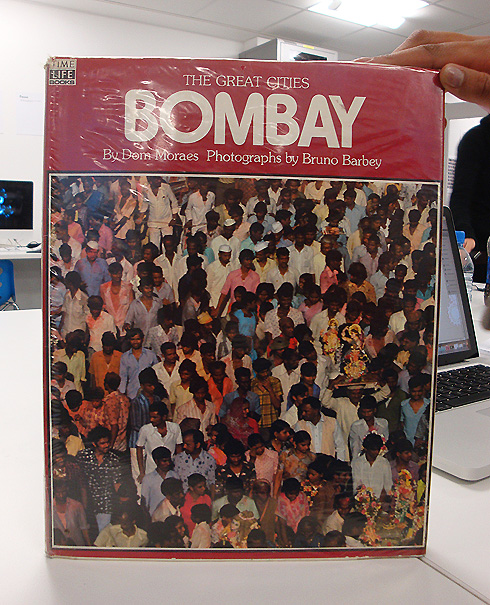
What followed was a group analysis, dissecting the object in terms of semiotics, its source, context, its materials and other relevant factors that give it meaning. After the analysis each person was given a new brief: to convert or transform the object into a graphic work keeping in mind theanalysis and discussion. Each person was given two hours to create a finished piece of graphic work.
During the discussion several people mentioned "dots" as a recurring shape in the cover, as each person was reduced to a dot. Another point was how the photograph transformed many individuals into one large mass of colour. My aim was to reduce the cover to its basic colours and shapes. In one way the poster is a mockery of the original object, as it strips it of meaning. At the same time is still comparable to the original when placed next to the other because of similar shapes, alignment and colours.
Abigail Reynolds
Abigail Reynolds: Layering and tessellation.

"The Universal Now: Relief sculptures using found photographs of the same place taken at different times." | Seventeen Gallery.
Reflection: Contemplating possibilities of adding layers to the already existing two layers of light as projections. It is possible that a third city panorama could exist behind the two already conceived, though it would be a print or a painting. It could also be a texture to add another layer of interactivity, that of touch.
26/11 Attack: Video footage
Documentary footage from the 26/11 attack on mumbai where 9 gunmen left more than 170 people dead over 3 days, and targetted the Taj Mahal hotel, Oberoi, Cafe Leopold (which I still frequent), CST and Cama Hospital. Created by Dan Reed, Terror in Mumbai uses CCTV footage and recorded conversations between the gunmen and their handlers in Pakistan to create a realistic picture of what happened that day.

(Image: BBC Source)
[vimeo http://www.vimeo.com/15290936]
[Video Source: Channel 4, HBO: Dan Reed]
This is an important aspect in creating the cityscape that shall represent the "here" rather than the elsewhere, the reality of what Mumbaikars have to face everyday.
Documentary: Changing face of Dharavi
Changing face of Dharavi, a documentary by journalism student Anisha Sharma. [youtube=http://www.youtube.com/watch?v=Tv8KC1bES50]
Sally Mackey: Practice as Research
My notes from the talk by Sally Mackey : Key questions: the key questions of your research are a work in progress as you evolve through the project: PROCESS driven. The importance of process (rigor and significance) versus the final product (as in the final product cannot stand on it's own).
Laboratory : creating a set up to enquire into your key questions.
Dissemination of research: Can an artwork disseminate knowledge (your research) on its own without an abstract? This is especially important in temporary art - or 'ephemerality of performance'. Peer Review: The importance of getting published, that is, other people (relevant to the field) should comment on your work, write about it, so that it is acknowledged as practice as research. These are all outcomes, ways to disseminate (DVD, websites, papers, articles, reviews, etc.)
Complimentary Annotation (documentation): Photos, bits of material, video clips, notes, etc.
The Elsewhere
The song-site in Bollywood movies is a good example of the imagined elsewhere for middle and upper-middle class Mumbaikars, where we are suddenly transported from the streets of Mumbai or the here, into an ideal place frequently represented by Switzerland, New Zealand or Germany; a dreamscape that is actually being built (Fig.1) through the efforts of architects and builders who have realized and understood this desire amongst aspiring Indians (Ashraf, 2005, p. 68):
The longing for elsewhere is now embodied in new building configurations that are radically altering the urban landscape: malls and shopping centres, cineplexes and flyovers, and exclusive apartment or residential complexes.
Using popular commercial styles of architects such as Hiranandani and Hafeez Contractor, the elsewhere will be a seamless city inspired by exclusive residential complexes and sets from Bollywood movies.
A complete contrast to these new structures that boast luxury, the reality or the here is that two-thirds of Mumbai’s population live in slums that lack basic amenities such as water, health, education and sanitation (Jonas Bendikson, 2008). This is how the majority lives even as they aspire to the ‘elsewhere;’ consuming popular Bollywood movies that sell dream-like images of what India could be. The here will be represented by a fragmented collage of conflicting identities in Mumbai today, a panorama based on images of everyday streets, slums, art deco buildings and famous landmarks.
[The full essay with references and images is available here: Study_PlanFNL5]
The Places We Live
The website is an interactive multimedia presentation of how people live in urban slums. Dharavi is represented with a combination of interactive space, photographs, stories, and sound. I saw this about one or two years ago, and now that I am finally in a position to spend time researching my city, I remember how much this spoke to me. It manages to articulate, to some extent, what it is like to live in the slums of Mumbai. Although I have never lived in a slum, the use of everyday street sound is haunting and familiar, nostalgic now that I am not living in Mumbai.
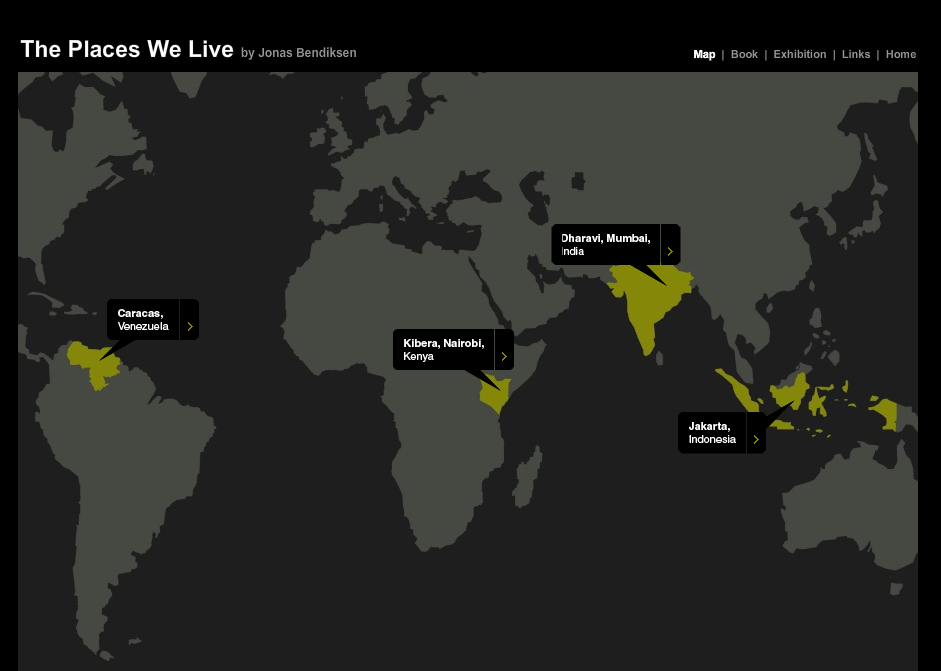
The exhibition and website are based on Jonas Bendikson's documentation of how people live in slums around the world The exhibition was first put up in 2008:
Research: its Aims and Structure
Phil Jones spoke about his thesis 'The Bones of the Book: Schematic Structure and Meanings made from from Books' and it lead me to question my Study Plan immediately. It is only a synopsis right now, but in time I should be confident of where my research stands in the academic world. These are some pointers from Phil on how to structure your research, in my own words: > The Subject This is the underlying aim, drive or motivation behind my work.
> The Field What is the state of interactive media today? What is the most current research and art in this field, and how and in which direction is it moving towards. What are the factions etc.
> Research Question Specifying the focus of the study using relevant technical terms from my discipline, in a question format. Aim, Objectives (Detailed aim) will flow from the research question.
> Theoretical Context World view, philosophical point of view, which will then influence your practice, awareness.
> Methods Connected to your theoretical framework.
> Claims and Truths Provably true, probably true (statistics) or plausibly true (convincing argument)
> Prediction of the form of the final presentation
Explication
Or making the implicit, explicit. That was the goal when writing my plan for phase 1 of the MA project. What I achieved though was a brief overview of the project's main aims as they stand now, and how I plan to accomplish them within the given time period: My aim is to create an interactive experience or object that represents a slice of the city Mumbai. Using visual language that symbolically represents the city’s dichotomies and conflicting identities, I propose to explore the city’s depth and complexity through the combined use of an appropriate form language, relevant technology and multimedia.
Download the full PDF here: Study_Plan (2.5 MB)
London Exhibitions
My first trip to Tate Britain and the V&A: Looking at a wide variety of artists from Fiona Banner, Muybridge and Mondrian to Rachel Whitereed.
My visit to Tate Britain and the V&A in London was helpful in several ways. First off, Fiona Banner's work Harriet and Jaguar made a huge impact on me. The fighter jets looked beautiful and awe inspiring, especially because of the way they were placed in the museum gallery. In a way she has transformed them so that it's difficult to remember that these are deadly machines: war planes used to kill people.

Another image from Fiona Banner called Top Gun (1994), this is a close-up I've taken. It interested me because of the way it pulls you in and persuades you to read more.
Inverse Reverse Perverse (1996) by Cerith Wyn Evans at the Tate, London
Inversions (1966) by Mary Martin
Structure 14c (1961) by Stephen Gilbert, at the Tate London.
Of all the work by Eadward Muybridge that was exhibited, Panorama of San Francisco from Street Hill (1878) was the one that came closest to affecting my practice as an artist. The idea of a landscape or panorama of the city of Mumbai had been churning in my head for a while, and experiencing this work at this scale helped me focus on the concept as a method of depicting a rich space. The landscape format reveals more of the city than what is seen normally, or parts of the city like they have never been seen before; a disillusioned and yet enlightened reinterpretation of a physical urban space. I will explore the landscape format in more detail in a later post.
Update (8th Dec): Photo documentation of more exhibitions I've visisted here.
Mind Map
I had so many ideas, theories and directions I wanted to explore that a good old fashioned brainstorming was the only way to start.
Trying to pin down what exactly this MA thesis is going to about is no easy task. I had so many ideas, theories and directions I wanted to explore that a good old fashioned brainstorming was the only way to start. Check out it out here.
